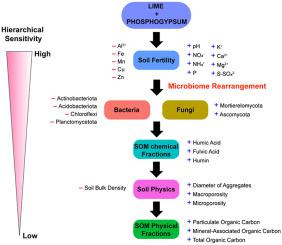Soil Biology and Biochemistry ( IF 9.8 ) Pub Date : 2021-03-04 , DOI: 10.1016/j.soilbio.2021.108188 João W. Bossolani , Carlos A.C. Crusciol , Márcio F.A. Leite , Luis F. Merloti , Luiz G. Moretti , Isabô M. Pascoaloto , Eiko E. Kuramae

|
Unsustainable agricultural management practices such as non-conservationist tillage and overuse of fertilizers result in soil acidity and, in turn, soil degradation due to reduced carbon (C) concentrations and nutrient availability and increased aluminum toxicity. Application of lime (L) and phosphogypsum (PG) can overcome these constraints and improve soil quality, but the long-term effects of these amendments on both abiotic and biotic soil properties are not known, particularly when applied in combination. Here, we evaluated the effects of L (acidity corrective), PG (soil conditioner), and their combination (LPG) on soil organic matter (SOM) transformations, soil chemical and physical properties, and microbiome assembly in a long-term experiment under a no-till crop rotation system in a tropical soil. The Ca-based soil amendments increased C concentrations (labile and stable fractions), improved soil physicochemical properties, and changed the associations between several bacterial and fungal groups. Contrary to expectations, the acidic soil amended with PG exhibited greater number of significant shifts in the bacterial community than soil amended with L or LPG, as well as higher soil bulk density. By contrast, the fungal community underwent greater shifts in soil amended with L or LPG, which had higher macroporosity. L and LPG amendment shaped the fungal community and rearranged the SOM fractions at similar rates, suggesting an essential role of the altered fungi in SOM transformation. In addition, combining L with PG increased the relevance of many low-abundance microorganisms, especially fungi, compared with the control, indicating an increase in their ecological role in the soil. Finally, by applying general joint attribute modeling and sensitivity analysis, we determined that soil fertility increased most in LPG-amended soil, as the ensuing changes in the bacterial and fungal communities resulted in improved SOM fractions, soil physical characteristics and, ultimately, soil quality.
中文翻译:

通过长期的基于钙的土壤改良剂调节土壤微生物组,可提高热带免耕作物轮作系统中的土壤有机碳和理化质量
不可持续的农业管理做法,例如非保护性耕作和过度使用肥料,会导致土壤酸度升高,进而由于碳(C)浓度和养分利用率降低以及铝毒性增加而导致土壤退化。石灰(L)和磷石膏(PG)的使用可以克服这些限制并改善土壤质量,但是这些改性剂对非生物和生物土壤特性的长期影响尚不清楚,尤其是组合使用时。在这里,我们在以下长期实验中评估了L(酸度校正剂),PG(土壤改良剂)及其组合(LPG)对土壤有机质(SOM)转化,土壤化学和物理特性以及微生物组的影响。热带土壤中的免耕作物轮作系统。基于钙的土壤改良剂增加了碳的浓度(不稳定和稳定的分数),改善了土壤的理化特性,并改变了几种细菌和真菌之间的联系。与预期相反,用PG改良的酸性土壤比L或LPG改良的土壤在细菌群落中表现出更多的显着变化,以及更高的土壤容重。相比之下,真菌群落在L或LPG修正的土壤中发生了较大的变化,而L或LPG则具有较高的大孔隙度。L和LPG修正物塑造了真菌群落,并以相似的速率重新排列了SOM组分,表明改变的真菌在SOM转化中起着至关重要的作用。此外,与对照组相比,将L与PG结合使用可提高许多低丰度微生物(尤其是真菌)的相关性,表明它们在土壤中的生态作用增强。最后,通过应用通用的联合属性建模和敏感性分析,我们确定了LPG改良土壤的土壤肥力增加最多,因为随之而来的细菌和真菌群落的变化导致了土壤有机质分数,土壤物理特性以及最终土壤质量的改善。 。










































 京公网安备 11010802027423号
京公网安备 11010802027423号